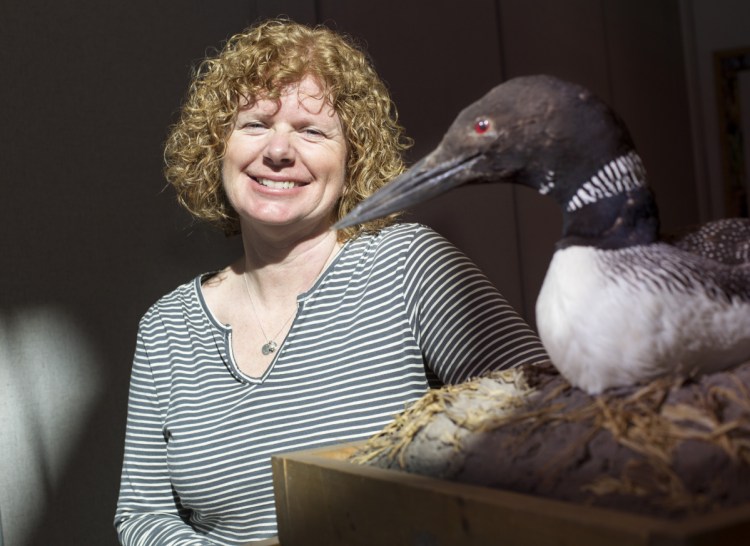Every year, in early summer, hundreds of Mainers head out onto lakes all across the southern part of the state. Their mission is to count loons. They lean out of kayaks, pause in their canoes and pull out binoculars to see if that is one little chick that mother loon has, or two bunched up together. Last July, 1,400 people participated in the annual count. They found just over 2,800 adult loons and 453 chicks.
Two things made them do it: the love of loons and the leadership of Maine Audubon’s Susan Gallo, the Source Award winner in the category of Conservationist. She’s been doing this job for 20 of the 35 years the count has been going on, and those in the birding and conservation world want her praises sung.
“Susan Gallo is one of those people that is behind the scenes and gets the work done but gets very little of the credit,” said Bob Duchesne, a member of the Legislature (D-Hudson) who is also the founder of the Maine Birding Trail.
He cited her work not just on Maine loons, but as the Audubon Society’s point person for bats and in the past, owls. (Loons make up about a third of her work time.) “On all of these studies she is involved with, she is doing much of the grunt work.” Expertly.
Gallo is a native of Cape Elizabeth, who came back to the state in 1998 after doing graduate work at the University of Montana. She returned at a time when her mother had cancer and she herself was going through a divorce; the loons were a lifeline back to Maine. Even after a good interview, she could hardly believe she had a chance at the job heading up the Loon Count. “I thought, ‘Oh, they will never hire me. I didn’t really have any direct loon experience.” Her expertise was in cavity-nesting birds, like chickadees and woodpeckers. But she landed the job and began traveling the state, where she encountered an uncommonly welcoming group of people: the Mainers who loved loons.
“They’d say to me, ‘Oh you are traveling three hours to get here, why don’t you stay at our camp?’ ” And so she did, and as she heard those loons at night, she began not just to understand, but share the love of the loons.
The count had been “chugging along” when Gallo took it over. But it was very old-school. The calculations were done by hand, the lists of counts were on stacks of graph paper. Her goal, she said, was to bring “a little bit more rigor to it.” She set about creating a database that could be continuously updated.
The loon count started at a time when there was serious concern over the species in New England. It had been extirpated from Massachusetts for nearly a century (the loon population there is coming back, slowly). In the course of the project, the number of adult loons in Maine has grown steadily each year, from 1,600 in 1984 to just over 2,800 in 2017. The number of chicks has fluctuated more, with counts as low as in the 200s in the 1980s to a peak of 600 in 2011. In 2017, the estimate was 453.
Outreach work with volunteers is one of Gallo’s favorite parts of the job, and she’d like to see some new, younger volunteers. “I love my loon counters,” Gallo said. “But we do tend to have an aging population of loon volunteers.” Over the course of two decades, she’s said goodbye to a steady stream of aging counters, who give up their lakeside camps or find it too hard to get in and out of the boat (boats aren’t required for loon counting, but they make it a lot easier). Her latest strategy? Working on an online data entry system that will more convenient for the next generation.
The job is more than data, though. Under Gallo’s leadership, key pieces of legislation have made their way through the Legislature. After doing necropsies on 500 loon carcasses collected over the years, it became clear that the small lead sinkers used by sport fishermen were all too often ending up in the bellies of loons. Lead poisoning was killing them. In 2002, the Legislature agreed to ban the smallest of these lead sinkers, and in 2013, voted unanimously to ban them altogether in favor of loon-friendly, non-lead sinkers.
Anne Haskell, a retired legislator who sponsored the legislation, worked with Gallo at Maine Audubon to craft legislation that would work for everyone, including the fishermen, the birds and the people who love the loons and what they signify.
“There is nothing that represents more what it is like to be ‘at camp’ than to think about being there just after the moon comes up,” Haskell said. “And you’re sitting by a little fire and then you hear the loons crying and singing. When you hear it, it is unlike anything else.”
Quietly, Susan Gallo has given a good portion of her career to making sure you can still hear that sound in the dark of a summer night.
Mary Pols can be contacted at 791-6456 or at:
Twitter: MaryPols
Send questions/comments to the editors.



